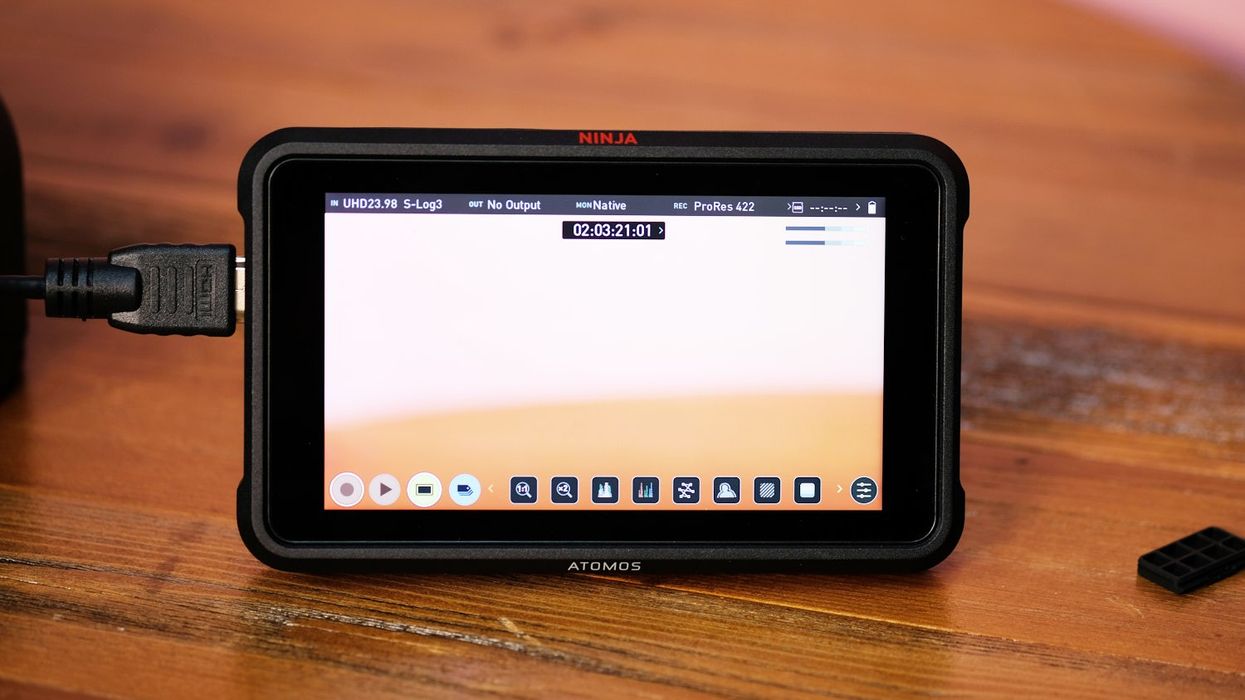We Go Hands-On with the Ninja V Pro Kit
Hands-on with the most affordable monitor/recorder from Atomos.

There are only a few areas of the film industry where there is clearly one vendor that outshines all others. Almost every market has a few big competitors: Sony vs. Canon, Sony vs. Panasonic, Zeiss vs. Cooke. Even in 35mm cameras where ARRI bodies were very dominant, there was still Aaton and Moviecam and (sort of) Panavision.
But not so in monitor/recorders. While there are some others out there (Odyssey, though they have moved on, and Sound Devices Pix, and Blackmagic), there is really one dominant player in this space right now, and that is Atomos.
We got to spend some time hands-on with the entry-level unit, the Ninja V Pro Kit.
Atomos Ninja V Pro Kit

- Streaming capability in combination with the included Atomos Connect
- Record up to 6k RAW via both HDMI and SDI at up to 12-bit in Apple ProRes RAW
- Video inputs up to 4kp60 supported via HDMI or 12G SDI to Apple ProRes or Avid DNx
- Configurable SDI for Single or Dual link inputs or toggle between SDI A and B
- Play out provides 3 simultaneous outputs via 2x12G SDI out and 1xHDMI in 10-bit up to 4K60
What is it?

In terms of monitoring, you get a whole host of tools that you aren't likely to get from your typical small camera. In addition to focus assist tools and zoom-in tools, the most popular is false color, which assigns clearly to read colors to different exposure values.
In terms of internal recording, since SSD's are cheaper than CFexpress and available larger, you usually get longer shoot times. Your monicorder also generally records to something like DNxHD or ProRes, which is ready to edit right away without delay waiting on transcoding compressed camera files. With many cameras putting out robust signals to their outputs, you can sometimes even get better quality imagery to the external monicorder.
RAW
In fact, with many modern cameras, raw recording is available only to the external recorder, not the internal. This is for a lot of reasons, one of the biggest being record speed limitations for internal media and also file size issues. Atomos worked closely with Apple on the original creation of ProRes RAW and has been pushing the format extensively to make it an open-source RAW format that all can embrace and support.
As general supporters of open source platforms, we like ProRes RAW and are glad to see its support in Final Cut Pro X, Premiere, and Media composer. We're still hopeful that we'll see its native support in DaVinci Resolve sometime soon.
Because of the RED patent on internal RAW recording, we're still in a world where a lot of cameras can't do internal RAW (without paying the license fee). Blackmagic gets around this by only being a partial RAW (it does a partial debayer), while ProRes RAW is a full RAW, but doesn't record internally. It has to go to an external recorder. This makes the Atomos units an attractive method for working with RAW for both users and manufacturers, who avoid paying for the RED license fee but still get RAW support.
The only other major platform to support ProRes RAW is DJI with the Inspire 2, which gets away with it since the "camera" is in the gimbal mounted to the drone, and the recorder is "external" up in the body of the drone.
The Ninja V
The Ninja V is the smallest monicorder in the current lineup but has a few design features that make it a smart balance for filmmakers looking for a monicorder. It supports up to 4K resolution, does ProRes RAW, and runs off of the common Sony NP batteries that every filmmaker already has a pile of.
So how do they keep the price down?

For instance, SDI. While it makes a lot of sense to just stick with HDMI on the 5" Ninja lineup since it'll mostly be paired with small cameras (and you can get the Shogun 7 for SDI connectors, which are typically on larger cameras), there are times you might want SDI on the little unit.
Not the typical use case, not something to bundle into every unit, since for most users it'll be a waste of space, but something you want the option for.

SATA
Another feature we appreciate about the Ninja V is that it uses a standard old SSD connector, which you can see right behind the SDI ports above. You'll want to buy SSDs that have rails on the side to slide in easily, but then those SSDs can be read by any SATA reader.
They are so cheap that we keep one at home, one at the office, and one in our camera bag just to be sure we can always read SATA drives when you need them.
When you compare this with the price of stocking up on REDmag readers that run $50/each, for instance, this design decision is one we appreciate.
Conclusion
The Ninja V Pro Kit is the "entry-level" Atomos unit, but that doesn't mean it doesn't offer a tremendous level of functionality for its price and size.
It's significantly smaller and lighter than the Shogun 7, but still offers a ton of the same functionality (though it does lack the multi-channel recording, that's a feature that is wonderful but not vital).
4K is still the most common recording format, and adding this unit to something like an a7S III for longer runtimes, bigger monitoring, and better image evaluation makes for a dynamite combo.
Let us know your thoughts in the comments.











